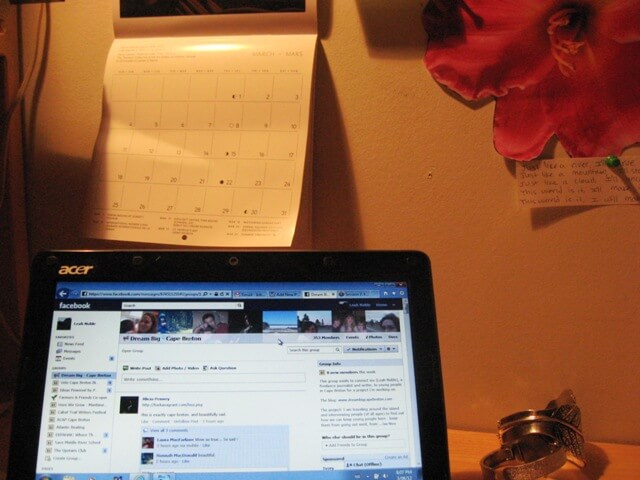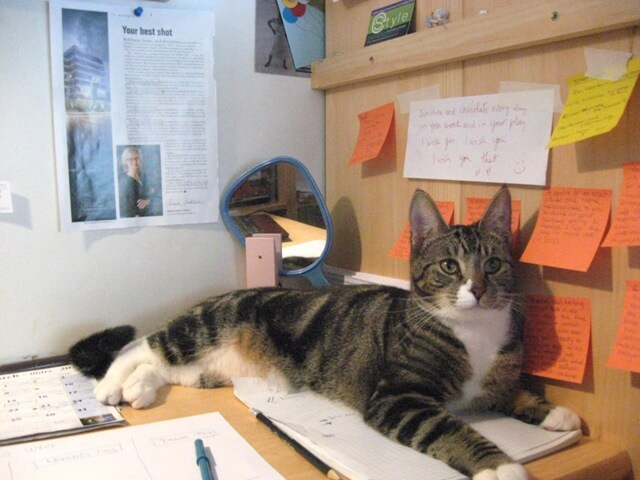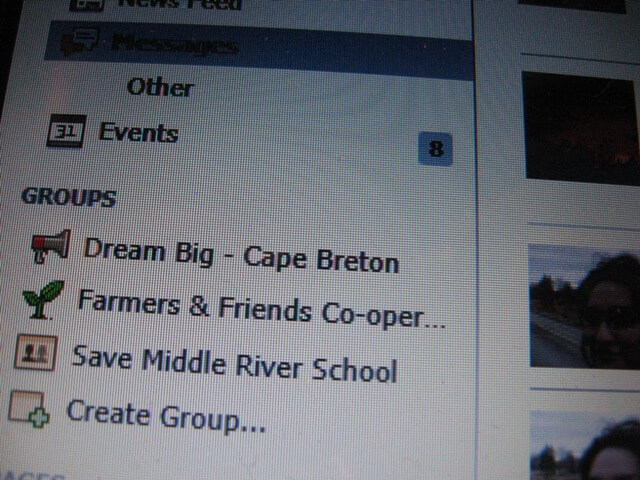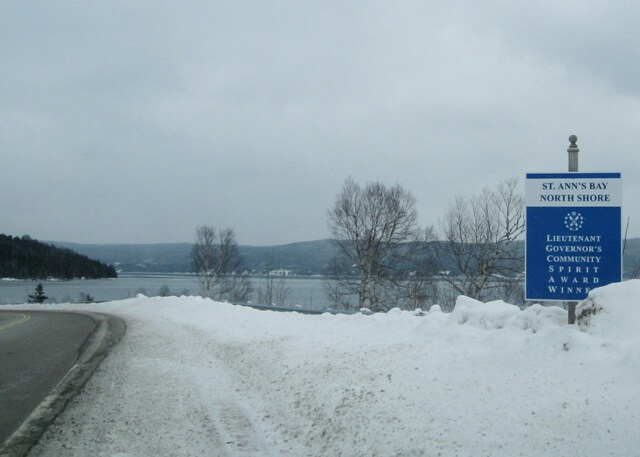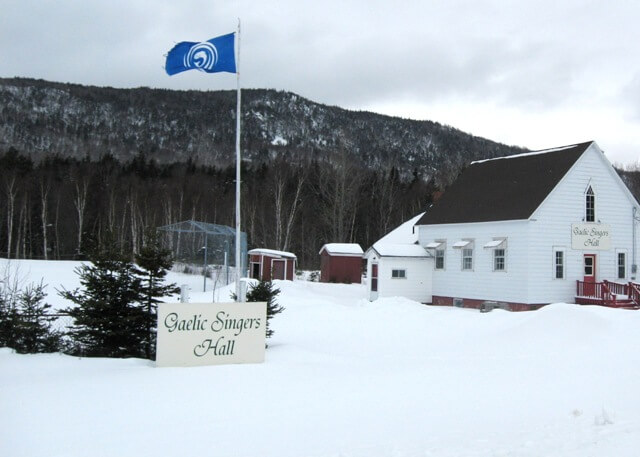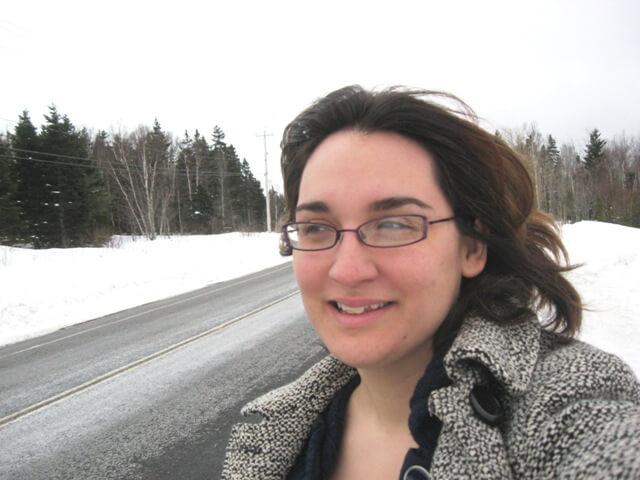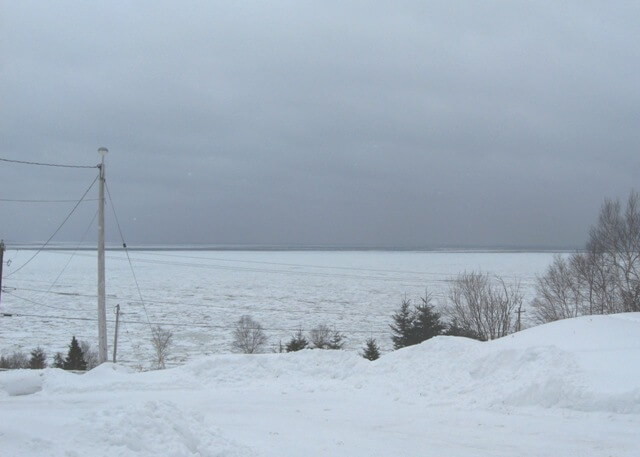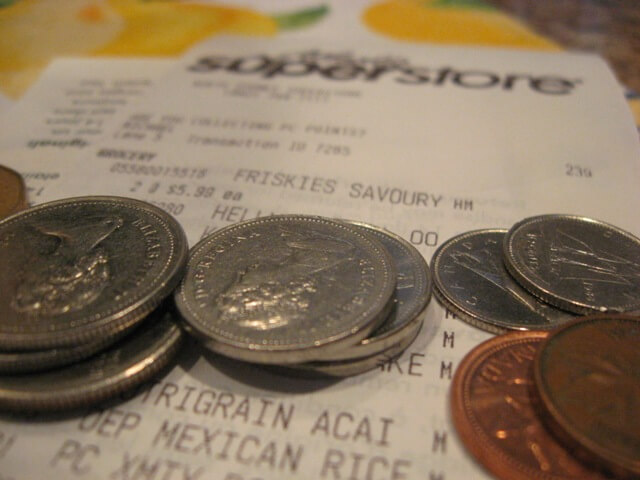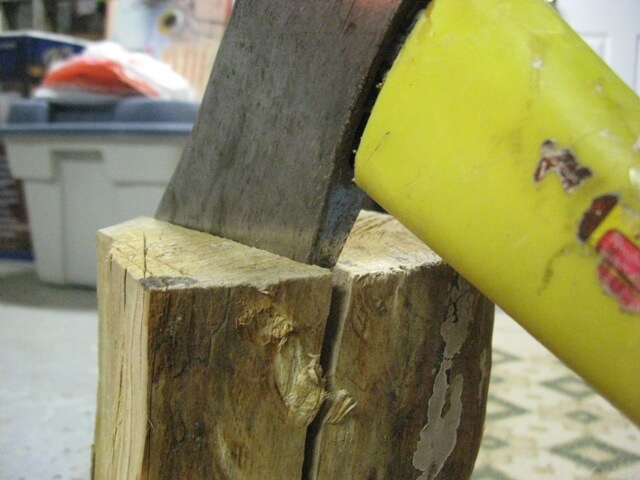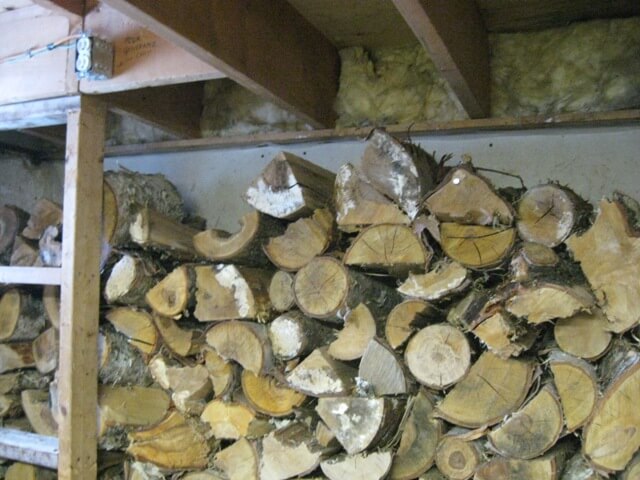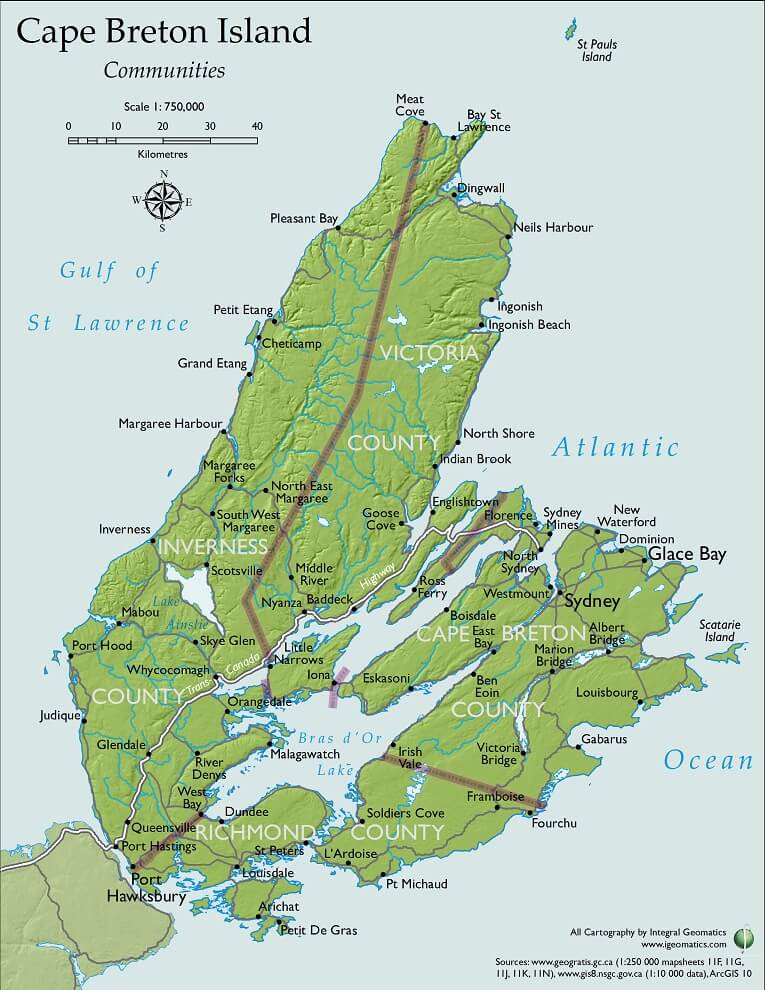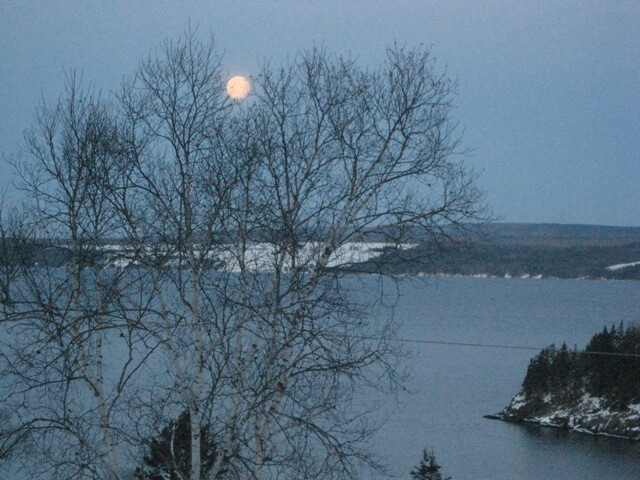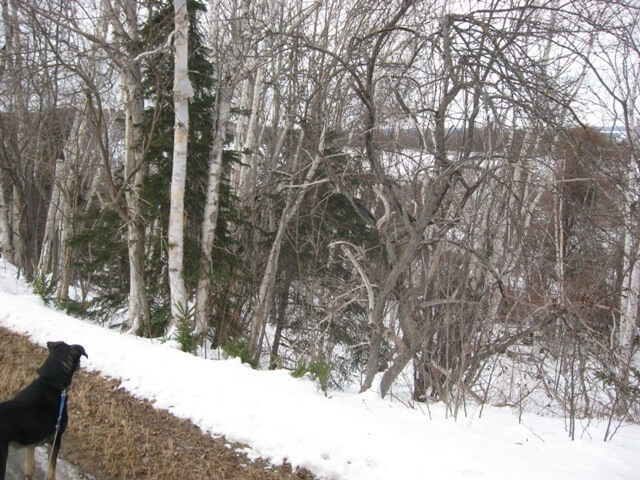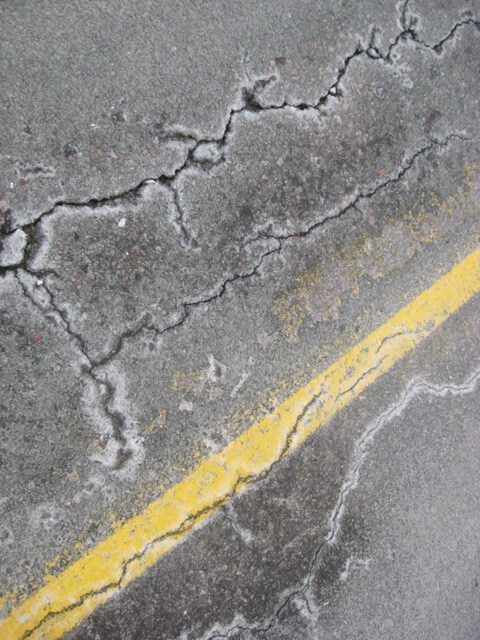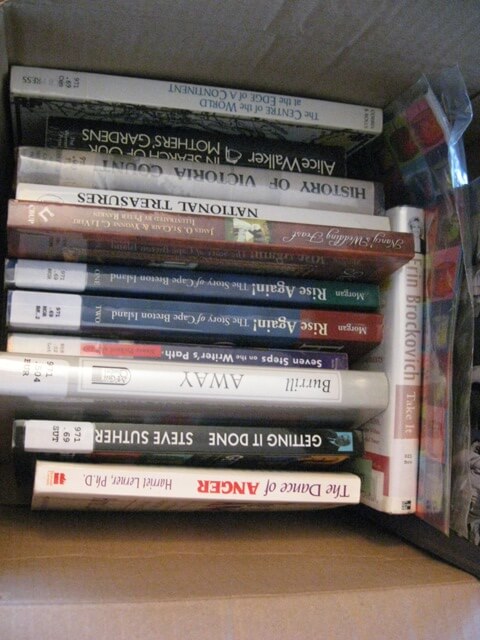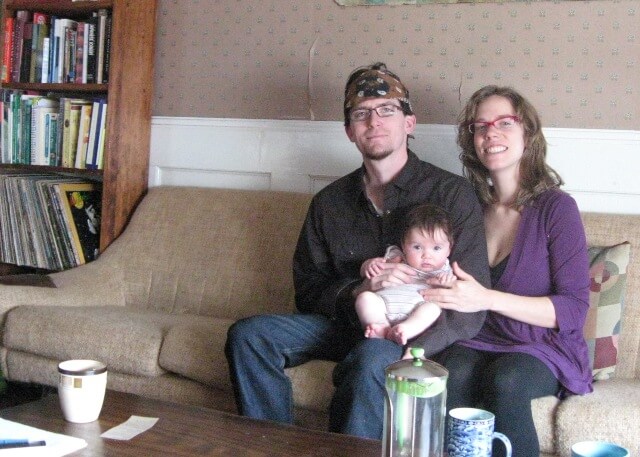
Brian Dean and Erin Phillips and their 4-month-old daughter, Miriel.
Brian Dean and Erin Phillips live in Whitney Pier with their 4-month old daughter, Miriel. On one of the coldest days of the so-far mild winter, Feb 13th , I drive through Sydney and out to the Pier for a visit. Erin meets me at the door with the baby bound to her chest by a cloth sling, and wearing a pretty eggplant-colored cotton dress and black leggings. Their old home, made comfortable with second-hand vintage furniture, colorful artwork and lots of healthy green plants, is warm inside on the cold afternoon. Brian comes down the stairs from his third-floor workshop to say hello, and I follow him back up to begin the tour.
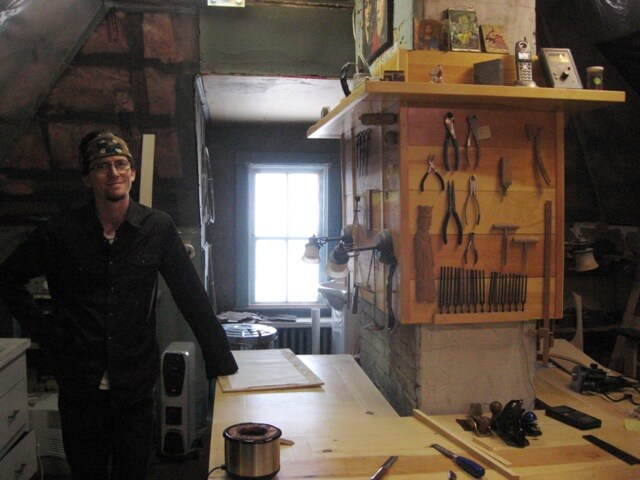
Brian in his attic workshop.
The attic steps open up into a cozy workshop – there are two big freestanding workbenches and another wrapped around the brick chimney. Tools, wood shavings, blocks of wood, and mandolins in various stages of completion make up the scene. The room is obviously still under renovation, with insulation visible under plastic in parts of the ceiling and walls, but it is also neatly organized and home to a dedicated craftsman.
Brian: “I’ve slowly made this attic space into one big room. It’s taken three years… it wasn’t insulated til recently. And just below these crossmembers here used to be the ceiling, now it goes all the way up. It used to lose a tonne of air, it was really hard to keep it air-conditioned or heated. I’ve always got a dehumidifier, and a humidifier running, depending on the season! The humidity is always constant for the job I’ve got to do.”
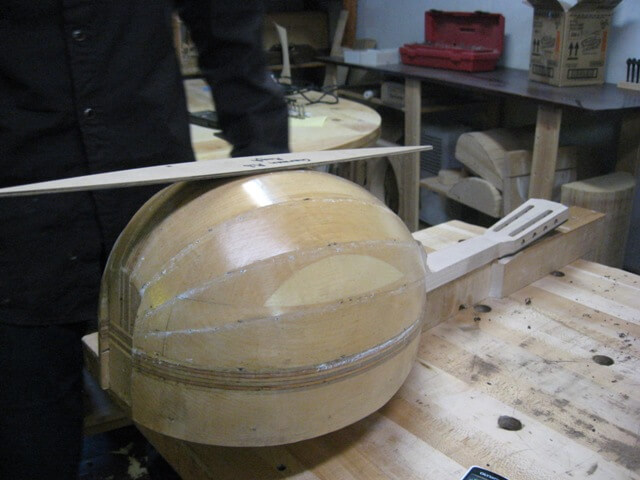
A thin piece of wood just resting on top of the bowl-shaped mold.
I look around the shop and have Brian show me the process of building a mandolin. He starts with drawings, then saws thin pieces of wood and shapes them, securing them together on various moulds to create different bowl shapes. He’ll then brace a spruce top and attach it to the bowl, decorate it with bindings, and attach the fretboard. It is a two-month process to the completed instrument.
If it weren’t for the Internet, Brian wouldn’t be able to live here. (You can see his website here.) “It’s true, there’s not that much work here. It’s hard to find. You have to make your own… opportunities. That’s not such a bad thing, who doesn’t want to make their own schedule in life?”
Brian grew up in Virginia. At age 8 he attended an art school one day a week, in addition to his public school classes. In High School he took wood shop, and learned some rudimentary carpentry skills. “And then I went to college. I was going to do engineering, because I wanted to use my brain, but then I started thinking about all those hours spent indoors, sitting in front of a computer, under fluorescent lights, being still. And…I was in the middle of the Appalachian forest at that point, and I discovered the outdoors. And I discovered folk culture. Music was a huge influence for me.”
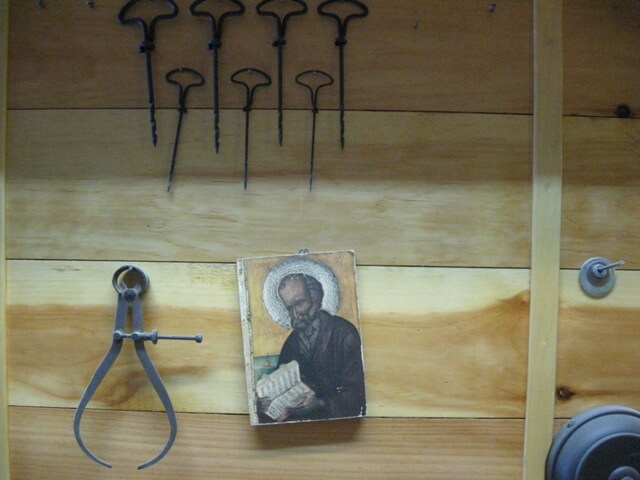
Religious art that belonged to Brian's grandfather, who was from Greece, hangs next to Brian's tools.
Brian continued on the base he’d built in high school, and signed up for a course that allowed him free access to the university’s woodworking and metal shops. There he built working, Medieval replica crossbows, some walnut end-tables, and eventually his first musical instrument – an Irish harp.
Over the next few years Brian would end up emigrating to Canada to live in Montreal, where he would eventually meet Erin, who grew up in Brighton, Ontario. Brian did carpentry for a time with Cirque de Soleil building sets, before being able to strike out on his own as a luthier. He says, “A lot of people have a romance with luthiery. But… it takes a lot of practice. Malcolm Gladwell says it takes 10,000 hours to master a skill. A lot of those hours were unpaid in my case, it’s not a free ride. Rather it’s a lot like an investment – but you have to put in the time if you want to be free.” Much of Brian’s inspiration came from his time spent living in Old Montreal. “You’ve got to find something that lights your fire.. In my case, it was this culture that put me in touch with my European roots.”
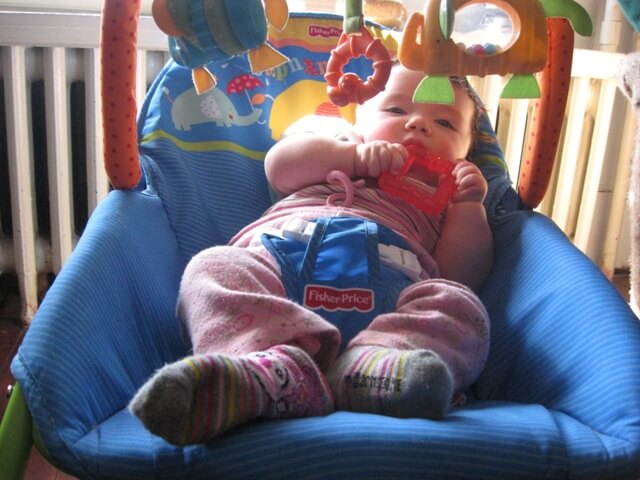
Mirel in her vibrating baby chair.
We head back downstairs where Erin has made a pot of mint tea and I bring out the plate of brownies I made. Miriel hangs out in a vibrating baby chair or on either of her parents’ laps, throughout the interview, eventually falling asleep as Brian softly jiggles the knee that she sits on.
They tell me about how they came to live here.
Brian: “We were in Ontario at the time. We discovered we weren’t very welcome in the small, isolated community we were in. They were very suspect of out-of-towners. They viewed us as temporary there even though Erin had a respectable job in the community. We had this one neighbor give us a lot of flak for not cutting our grass, even though we lived way out in the country. But, I wasn’t really interested in moving, since we just moved the year before. And we had our own lake, our own dock.”
Erin: “But you weren’t interested in staying, either!”
Brian: “I would have, if the community had welcomed us. And, except for the price of living. It was, you know, Ontario cottage country. It was cheaper to rent than to own, so we would never actually have our own place. So Erin looked for jobs and found one here [with the Cape Breton Regional Library]. And we knew a little bit about the Maritimes, because we had already visited PEI the year before, where we ended up camping at a fiddle fest with a bunch of Cape Bretoners. They were the rowdiest, most fun people at the festival! They all seemed to have farms, land. They weren’t rich people, just average people. This one guy said “I have to go home to feed my chickens!” And in Ontario you practically have to be rich, or inherit land, to live like that.”

The road their home is on.
The house they are in is the first one they looked at. It was a fixer-upper, but Brian is handy, and it was right on a bus route to Erin’s workplace. Their mortgage is also only about 15% of their total income, they estimate. “Versus on average 35-40% for most people. We’re going to have it paid off in 3 to 4 years. I mean, we’re on a tight budget, we’re very aware of our money. But, still. It’s possible to do that here – homes are pretty affordable.”
Whitney Pier is a former industrial community, very close to the site of the former steel plant. The community has been here for about 150 years, and has always been a mix of cultures, immigrants who came to Sydney to work. Brian and Erin find it is a friendly place to live. While we were chatting, two neighbor boys, around ten years old, came and knocked at the door, asking to go out into Brian and Erin’s backyard to play with the two dogs. “Not today,” Brian said, “We’re busy.” “They come pretty much every day,” said Erin. “It’s cute.”
I ask them if they see themselves still here in ten years.Erin: “We’d like to be, but it depends – on where things go. I feel like right now things are progressing in the way we want them to be progressing. We’re meeting new people… You know, things do seem to be happening, like the downtown farmers market, this work that you’re doing [the Dream Big project]. There does seem to be a sense of community building. The kind of community we want to be a part of. It really sort of depends on how things go.”
Brian: “I think we play, people like us, we play a role – and it’s that of… not just waiting to see if it happens, but actually getting in there and helping create this infrastructure of change. For me, it’s a lot about the business aspect of things. I mean, it’s great to have community initiatives, but so much of what we do or don’t do comes down to our either having or not having the funds to make our ideas into reality. We’ve got to find ways of attracting and keeping more business in our downtown – family-run businesses, with a solid foot in the community, not in Toronto. Like an artisanal bakery – we don’t even have one in our downtown core! It’s really simple stuff, not at all out of reach. Either someone else is going to start it or in 10 years I’d like to.”
I ask him, “What are some of the things that you would do to help people start their own businesses?”
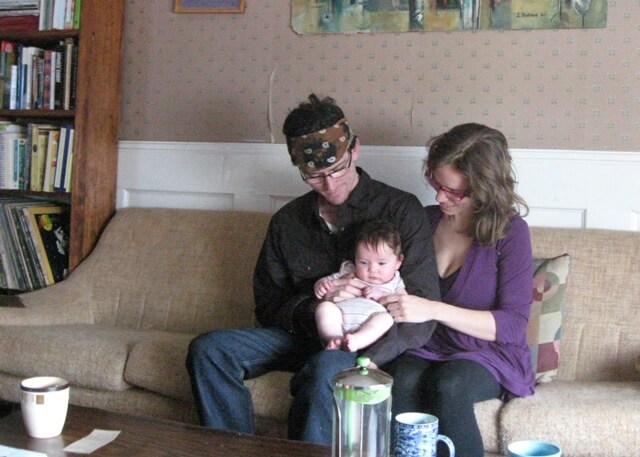
Proud mama and papa.
Brian: “I don’t think there’s anything you can do besides getting people educate themselves in business, and put their energy towards making it reality. You don’t even need a lot of money – a good idea finds its own capital. And you know, I’m all for social programs as well, but I do find Cape Breton more reliant on government than most places I’ve been, and I do see it as a stumbling block. Social initiatives are one of the things I love about Canada, but too much government involvement and you’ve got a broken system… you know, if someone is insulated from risk, from responsibility, they just don’t grow. We’ve all got to learn to stand on our own two feet and make mistakes, on our own initiative. There are of course business schools right here in Cape Breton, that will help people learn about and manage risk. First you’ve got to want it, then you’ve got to go out and get it. Success will follow naturally when you love what you do and when you’ve got the money management.”
Erin: “There’s that history here of the one industry too… if it’s always been a one-industry city, then people are always looking for the one industry to save them. And that’s why we get all this negativity in the news… because people are so down, because there aren’t many jobs. That’s understandable. But we need more… entrepreneurial spirit. And exposure to other areas, what people are doing in other areas.”
Brian mentions how twenty-five, thirty years ago Quebec wasn’t known for its cheeses the way it is now. “What did they do in the last twenty years, to get all that? Well, they found an identification with the French culture. Once the cultural revolution started in Quebec… you know, the pride in their culture after they won back more of their rights in the 70s. They got in touch with their roots. They became proud of who they were. And you know, one of the indications I see around here, that people still aren’t proud of who they are, is the litter people leave around. When you’re proud of who you are, you take care of your surroundings, your island. There seems to be a lack of self-respect in some cases, I don’t know.”
“Now, how can that change? I don’t know. Maybe because of the history, the roots, Scotland is the place to look? Else we could just be proud to be Cape Breton. It really is an amazing, amazing place to live. Sometimes you have to be away from what you know before you come to respect what you have right there in your hand.”
We talked a bit about how stress and difficult times are necessary to growth and self-discovery. Brian: “It’s absolutely necessary to growth. Look at the European discovery of North America … people were dissatisfied with their homes, they had this yearning for something better. And if you’re already comfortable, you’re not gonna go for it. But if you’re oppressed, you’re gonna try for something bigger.”
“I find we’re too comfortable, with the government programs. And with them giving us these programs, we have the mentality that we’re damaged. We’re not successful, we’re victims. And that’s how people talk, if you read the letters to the editors. ‘Where are the jobs? Somebody come give us the jobs.’”
“But, there are some people coming back here from away and starting businesses. There’s this leatherworker, on Charlotte St, we met them, he and his wife came back from Alberta… I walked by his place one time and I see him out front smiling, shoveling his walk. And that says to me, you know, he’s proud of his business. Of what he’s created. He wants it to look good. He wants the other businesses around him to look good. He’s not just dreaming or scheming, and he’s got the backbone behind it. That makes me smile.”
We talk a bit about Facebook. I ask them how much they use it to build networks.
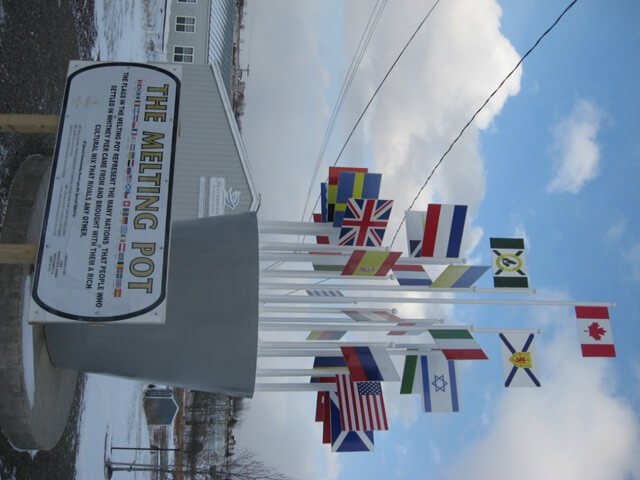
A commemorative landmark in Whitney Pier, celebrating the "Melting Pot" of Sydney.
Erin: “It’s interesting, I feel like, it reinforces links that I already knew were there. You meet someone somewhere and you add them to your Facebook and you find out through them that these other things are happening, based on what they’ve linked to and that sort of thing. So I feel it’s useful… in terms of the general awareness of what’s going on in the community. But I also read the paper and listen to the radio in the morning to find out what’s going on. And I certainly don’t think that Facebook IS the community. It’s helpful… for discussing things with people in, say, Baddeck, (laughs), but we [as a society] really are too dependent on it. And we really don’t get enough face-to-face interaction with people, anymore. We should be having more get-togethers, that’s what we should be focusing on, because that’s how we create community for REAL. The actual thing is created when we get together. The hopes and dreams of it may exist in the virtual world, but the actual thing is people, people eating together, working together, making music together, gardening together, whatever it is.”
***
I stayed – and taped! – over two hours worth of great, stimulating conversation, but unfortunately don’t have room for it all here. (Or the time to transcribe it!) After Miriel fell asleep it was time for me to head off. On the drive out of Whitney Pier I stopped and took a few pictures of the new multicultural statue of the flags, and thought about community, and place, and history.
Erin and Brian are both avid gardeners, and Erin has agreed to do some writing for this blog, sharing books that are available from the Cape Breton Regional Library on the subjects of gardening, community-building, and sustainability. I’m looking forward to seeing which books she picks!
***
And here is a video trailer for an upcoming movie about Whitney Pier, titled “Pier Dear”. Check it out for more information about the Melting Pot of Sydney.
